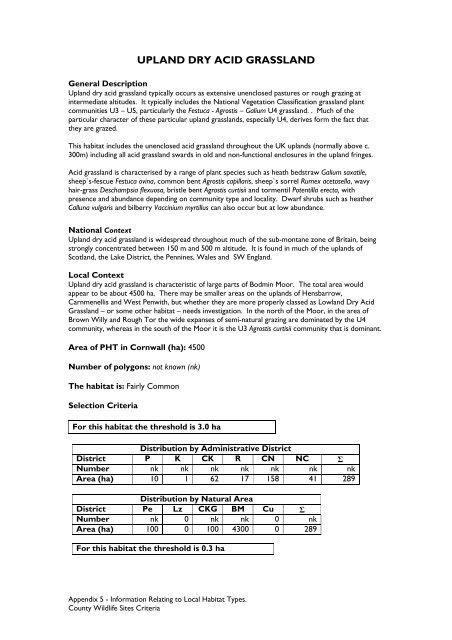County Wildife Site Criteria for Cornwall Appendices
County Wildife Site Criteria for Cornwall Appendices
County Wildife Site Criteria for Cornwall Appendices
Create successful ePaper yourself
Turn your PDF publications into a flip-book with our unique Google optimized e-Paper software.
UPLAND DRY ACID GRASSLANDGeneral DescriptionUpland dry acid grassland typically occurs as extensive unenclosed pastures or rough grazing atintermediate altitudes. It typically includes the National Vegetation Classification grassland plantcommunities U3 – U5, particularly the Festuca - Agrostis – Galium U4 grassland. . Much of theparticular character of these particular upland grasslands, especially U4, derives <strong>for</strong>m the fact thatthey are grazed.This habitat includes the unenclosed acid grassland throughout the UK uplands (normally above c.300m) including all acid grassland swards in old and non-functional enclosures in the upland fringes.Acid grassland is characterised by a range of plant species such as heath bedstraw Galium saxatile,sheep`s-fescue Festuca ovina, common bent Agrostis capillaris, sheep`s sorrel Rumex acetosella, wavyhair-grass Deschampsia flexuosa, bristle bent Agrostis curtisii and tormentil Potentilla erecta, withpresence and abundance depending on community type and locality. Dwarf shrubs such as heatherCalluna vulgaris and bilberry Vaccinium myrtillus can also occur but at low abundance.National ContextUpland dry acid grassland is widespread throughout much of the sub-montane zone of Britain, beingstrongly concentrated between 150 m and 500 m altitude. It is found in much of the uplands ofScotland, the Lake District, the Pennines, Wales and SW England.Local ContextUpland dry acid grassland is characteristic of large parts of Bodmin Moor. The total area wouldappear to be about 4500 ha. There may be smaller areas on the uplands of Hensbarrow,Carnmenellis and West Penwith, but whether they are more properly classed as Lowland Dry AcidGrassland – or some other habitat – needs investigation. In the north of the Moor, in the area ofBrown Willy and Rough Tor the wide expanses of semi-natural grazing are dominated by the U4community, whereas in the south of the Moor it is the U3 Agrostis curtisii community that is dominant.Area of PHT in <strong>Cornwall</strong> (ha): 4500Number of polygons: not known (nk)The habitat is: Fairly CommonSelection <strong>Criteria</strong>For this habitat the threshold is 3.0 haDistribution by Administrative DistrictDistrict P K CK R CN NC ΣNumber nk nk nk nk nk nk nkArea (ha) 10 1 62 17 158 41 289Distribution by Natural AreaDistrict Pe Lz CKG BM Cu ΣNumber nk 0 nk nk 0 nkArea (ha) 100 0 100 4300 0 289For this habitat the threshold is 0.3 haAppendix 5 - In<strong>for</strong>mation Relating to Local Habitat Types.<strong>County</strong> Wildlife <strong>Site</strong>s <strong>Criteria</strong>
















